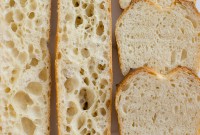Refrigerator storage: Feed once a week
Measure out 113g (1/2 cup) of the starter; discard the rest (or bake something with it). Feed this 113g of starter with 113g each water and flour. Cover it and let it rest on the counter until it starts bubbling (1 to 2 hours) before returning it to the refrigerator.

Room-temperature storage: Feed twice a day
Starter that's kept at room temperature is more active than refrigerated starter, and thus needs to be fed more often. Room-temperature starter should be fed every 12 hours (twice a day) using the standard maintenance feeding procedure: discard all but 113g, and feed that 113g starter with 113g each water and flour.

Why are time frames vague?
Want to be a successful sourdough baker? Relax! There are so many variables in sourdough baking that there's no possibility you can control them all every time out.
The vigor of your starter, the quality/complexity of your recipe, the hydration of the dough, even the weather outside — all combine to determine how much your bread rises, its texture, and what it tastes like. Experience is your best teacher: the more you bake with sourdough, the more comfortable you'll become with its "personality."
In addition, as you become familiar with sourdough baking you'll realize it doesn't have to rule your life; feeding every 12 hours doesn't mean, if you feed it at 4 p.m., you have to get up at 4 a.m. and feed it again; 7 a.m. will be fine. And if you miss a day or two of feeding (or a week, or two weeks, or...), don't worry. Your starter can almost certainly be revived by feeding it every 12 hours until it's healthy, then putting it back on its regular feeding schedule.
How to dispose of discard starter
Dislike throwing away your excess starter? Rather than simply disposing of your discard starter, you can choose one of our "discard" recipes and bake something tasty.
Of course, there are plenty of other ways to get rid of it.
If you compost, scoop it into your bucket or bin; it will quickly disappear into the mass of fermenting organic materials.
If you want to throw it away, it's best not to do so in its liquid state, as it can start to smell. Instead, pour it onto a piece of parchment or waxed paper and either bake it or let it air dry until it's brittle before throwing it away.
If you have absolutely no other choice, you could throw liquid sourdough starter down the drain — but do so with caution. You don't want the starter clogging your pipes. Place your discard starter in a large bowl and add cold water, stirring to thin it to the consistency of milk; then pour it down the drain, flushing the drain with additional cold water.
Will sourdough starter hurt your septic system? No, it shouldn't; it's simply organic matter and yeast. But again, make sure it's thin enough that it won't clog your pipes.

FAQ
Did I kill my starter? How do I get more sour flavor? Answers to your critical sourdough questions.
Learn more
Glossary
Learn how to talk like a baker with this guide to foreign words and sourdough jargon.
Learn more
